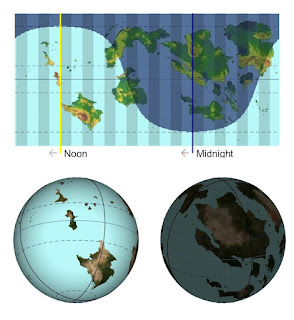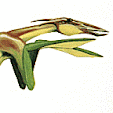I haven't changed the main Furaha website in quite some time. The odd thing about old sites is that sometimes animations stop working or images become invisible, even though they did work initially, and nothing changed.
I was asked by someone, who wanted to know more about animal locomotion, about some of these animations. I decided that some attention was long overdue and started work on it. I found that in some cases the case of one letter differed in the html file and the actual file name, so it seemed that html has become less forgiving. I also added -slightly- more modern html code to make the animation work better.
I then recalled that someone else had asked whether the old 'Furaha right now' page would ever be reinstated. That page showed pictures of the planet around its sun Jua and of the distribution of light and dark on the planetary surface, updater roughly every Earth hour. At one point I had to remove that page because at the time I could not store all 900 images for one year on the server, and so had to remember refreshing them every month or so. I have more room now, so I polished the output a bit, ran the Matlab programs again, transferred the 900 images and made a new menu item: 'Furaha right now'.
 | ||
| Click to enlarge; copyright Gert van Dijk |
Here is an example image showing a map with day and night areas, as well as two globes representing the dayside and the nightside of the planet, at one particular time of day and particular point in the planet's orbit.
If you revisit the page often enough, you may find out how humans on the planet devised a calendar to cope with their 551.1 day long year.
However, nothing else has been changed, because I do not have the time: I am working on The Book and a different art project altogether. But I will get to it. At one point.

4 comments:
I'll use the updated six legged locomotion animation to ask a question wich I think could be relevant to the discussion. From a comment here https://www.deviantart.com/vikasrao/art/World-of-Draconology-891773774#comments "Arthropod appendages are structurally very different from vertebrate limbs. And while you're right in that the main reason why vertebrates have 4 instead of 6 limbs is ancestry, it's a bit more complex. The vertebrate body plan is basically head, trunk, tail. The trunk is where the limbs and most organs are. Look at a vertebrate and you'll probably see this pattern repeated over and over: fore limbs, torso with organs, hind limbs. For something that started out with this bauplan, having an extra set of limbs in the middle would require some very complex organ shuffling. Insects and many other arthropods solve this problem by having all their appendages be on one part of the body, and their organs etc in another (usually the appendages are on the thorax or equivalent and the organs in the abdomen). Plus, given how heavy and complex vertebrate limbs can be it would require a lot of energy to actually be maintained, that's why animals just ditch them when they no longer have a use for it.
This is actually why I disagree with so many people criticizing the hexapods in James Cameron's Avatar because they move like quadrupeds. Having the 1st and 2nd limb pairs located in what I can only assume is an extended pectoral girdle designed to house 2 sets of limbs means that they don't need to figure something out for the organs (in the first movie the direhorse was shown to have a heart located in the same place we'd expect to see a typical terrestrial vertebrate's heart so I'm guessing their internals are similar)." This make me wonder, how are your hexapods organs organized within their bodies?
The speculative project this comment is taken from is very interesting by the way, if you plan on reviewing any more of such projects in the future.
Davide, I read the comments you quoted and must think some more about the reasoning there. At one point the writer mentions "For something that started out with this Bauplan, having an extra set of limbs in the middle would require some very complex shuffling". The Bauplan in question meaning 'head, trunk, tail'. I have two potential problems with the statement. The first is that this suggests the addition of a third pair of limbs late in evolution, which seems very unlikely for various reasons. Perhaps he or she did not mean that, or perhaps the question was whether dragons could evolve from tetrapod stock (I did not read the entire thread).
That brings me to the second problem: in evolution, the arrangement of limbs and the place of internal organs must evolve hand in hand (or perhaps 'gut in rib'?). If a Bauplan evolves with three sets of paired limbs, internal organs will evolve along the limbs, without any 'complex shuffling', as that supposes some previous arrangement. From there you can move between two extremes. The first is a body cavity shaped like an hourglass with a very narrow connection in between, perhaps just a gut, an artery and a vein. The other is one continuous body cavity with the limb girdle circling it, i.e., the bones really 'girdle' the cavity.
As for the Furahan hexapod pattern. I already mentioned the 'lateral fin theory' and 'scalata' ('scalates') in the blog previously. This early arrangement of fin strengthening rods becoming segmented limbs resulted in two lateral chains of bones linking the three limbs on each side; as animals grew and stresses increased, side to side connections also strengthened, forming 'girdles'. As in vertebrates, these girdles can be open or closed, flexible or stiff (middle ones, carrying most weight, are usually stiff). Because the organs evolved alongside with all this, there is a body cavity housing the necessary machinery inside. There is a middle indentation in the cavity, but it doesn't really deserve the label 'hourglass'.
You also also once promised to explain the importance of toes in locomotion. I'm still hoping you will. Your process is what draws people.
About once every month for several years now I think that I should now really, REALLY work on that post. Very well, it will appear before the end of the year; this year, meaning 2024...
Post a Comment